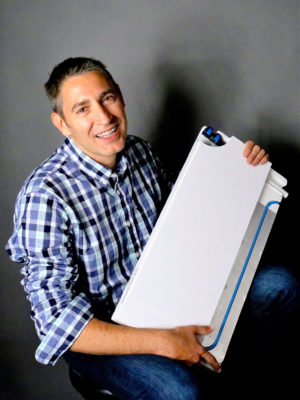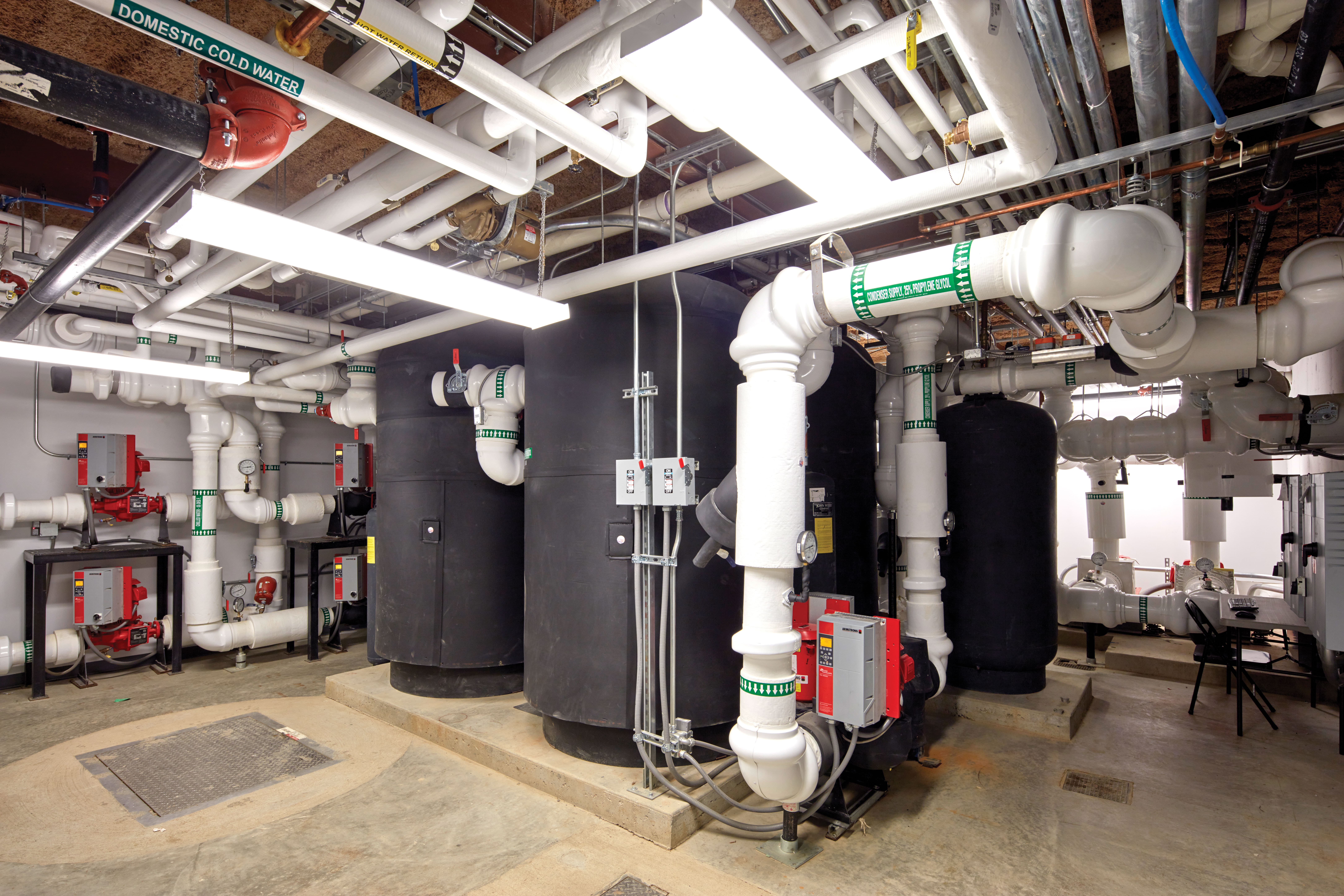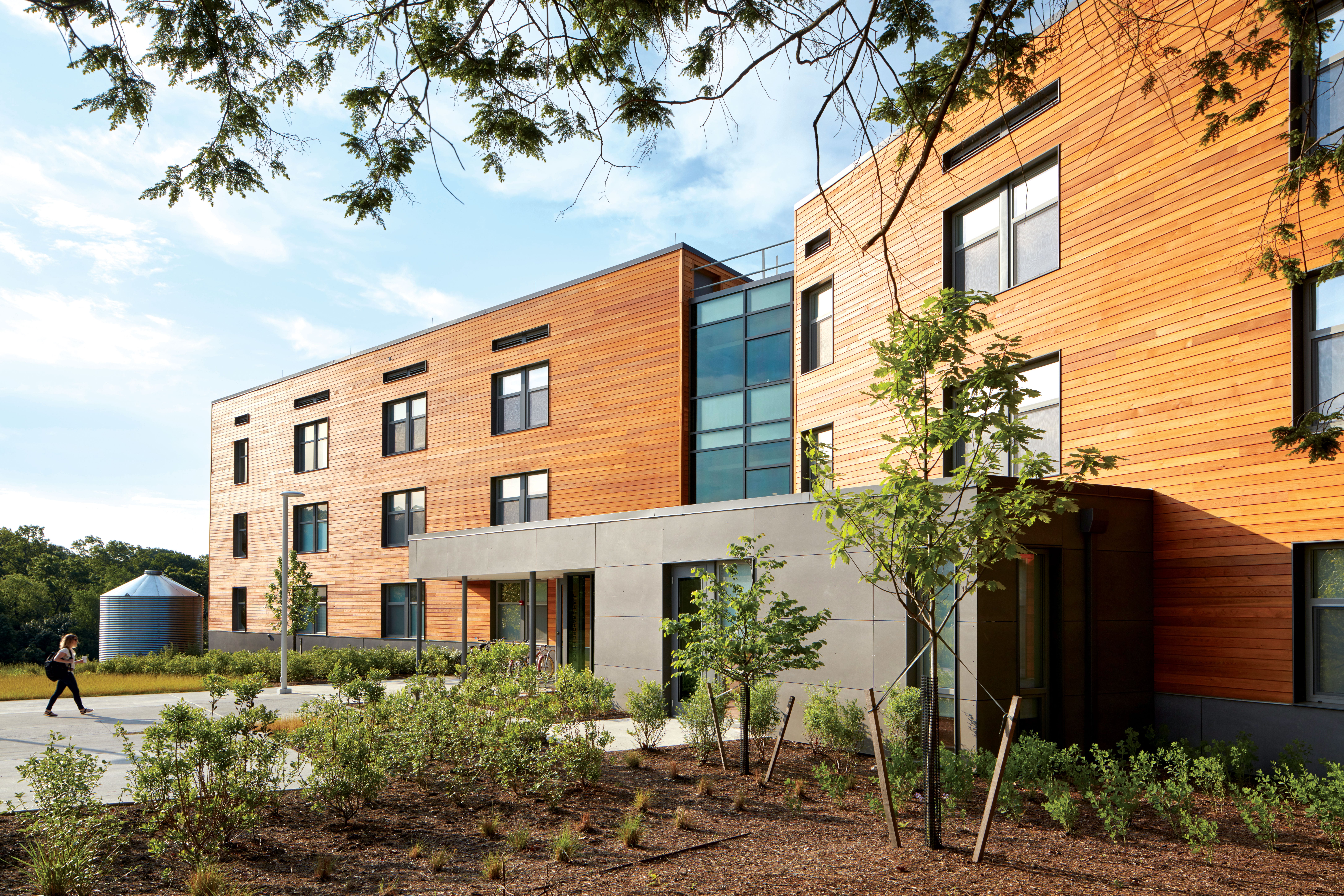Messana Radiant Cooling transforms energy performance at a progressive university
 Download a PDF of this story.
Download a PDF of this story.
Just north of Pittsburgh on nearly 400 acres, Chatham University is doing things differently. There, the Eden Hall campus includes the Orchard Residence Hall that opened in summer 2015, designed by Mithun to be one of the greenest dormitories in the world. But how to cool dorms in a humid setting without expending an abundance of energy? That’s where Messana Radiant Cooling comes in.
For decades, countries like Italy, Germany, and China have been using hydronic radiant cooling panels instead of traditional HVAC. The panels are easy to install, energy-efficient, and take up less space than air conditioning ductwork, according to Messana co-founder Alessandro Arnulfo. Messana is among the first to introduce hydronic radiant cooling to the states, and its Ray Magic system uses radiant gypsum panels to cool and heat rooms. At Orchard Hall, you won’t see or hear the system, but you’ll know it’s there. You’ll feel it.
Expanding on Greatness
From the start, Chatham University—named one of the top 50 green colleges by The Princeton Review—set out to create a campus that was sustainable first. When it comes to the dorms, Chatham wanted to keep students comfortable without wasting energy.
The campus’s high-performance buildings are designed to last 100 years, with operable windows to promote natural ventilation.
BY THE NUMBERS
39
The percentage of carbon dioxide emissions in the U.S. that are a result of buildings
40
The percentage of building energy use from HVAC systems
42
The percentage of energy radiant cooling systems are projected to save compared to air-based cooling systems
3,500
Water has roughly 3,500 times the energy transport capacity of air
5
A hydronic system can transport a given amount of cooling with less than 5% of the energy required to deliver cool air with fans
15
Studies show that for buildings designed to LEED Platinum standards, the construction cost premium (when compared to a LEED Certified building) is approximately 15%
20
Each building on the Eden Hall campus aims to use less than 20 kBtu/sf/yr
Eden Hall’s high-performance buildings are designed to last 100 years, emphasizing a small footprint, operable windows to promote natural ventilation, and geothermal technology to share energy between buildings. When setting out to build Orchard Hall, eliminating HVAC ducts was high on the to-do list, as the wood framed residence hall had height restrictions and a minimal design aesthetic. Radiant gypsum panels are minimal, and more headroom was a major benefit, according to Antonio Pares, principal at Mithun Solomon. Pares says the system also reduced mechanical noise—the rooms are largely silent as the panels have virtually no moving parts.
But What is Ray Magic?
The Ray Magic panel is a gypsum panel with pipes inside aluminum transfer plates. The pipes are attached to the supply and return line, and the panels, which come with the drywall already attached, are laser-engraved so that when you hang the panel, you don’t hit the pipe. “Basically, the panel itself is the drywall. When you install the panel on the ceiling, you don’t see anything. It looks and installs like regular drywall,” Arnulfo says. “The installation is very quick and easy.” You can also do all the molding and painting you want, and Messana can integrate pendant lights as well as sprinklers or speakers in the ceiling if desired.

Orchard Residence Hall at Chatham University.
[Courtesy of Messana]
The gypsum ceiling panel has another benefit compared to a traditional radiant floor—low thermal mass, which is key to radiant cooling so the system can react fast if, say, many people enter a room at once. This is important considering that humidity can cause condensation. The control system immediately detects this situation and increases the supply water temperature and, consequently, the ceiling temperature rises quickly. Gypsum or metal are the most fast-acting solutions for radiant cooling, but metal costs three to four times more.
Radiant Cooling Vs. Air Conditioning
A radiant cooling system can be 20 to 40% more efficient than traditional AC, Arnulfo says. Simulations done at Lawrence Berkeley National Lab compared traditional AC to radiant cooling in the floor across nine U.S. cities and proved radiant solutions saved 30%.

Messana co-founder Alessandro Arnulfo
Using radiant, you separate the sensible heating load from the latent load—something you can’t do with traditional AC. Sensible heat is what we perceive as temperature. It’s what we feel when we say, “It’s hot in here.” Latent heat is heat associated with humidity. When using AC, you treat the humidity and temperature with the same device. “This is one of the biggest problems of air conditioning,” Arnulfo says. “Humidity goes much lower than the human body likes, so it’s very difficult in air conditioning systems to treat. The air is too dry. Your skin is uncomfortable. And it’s a waste of energy.”
Using a radiant system, you treat the latent heat by using dehumidifiers while you treat sensible heat using radiant panels, maintaining a comfortable environment. AC is where a lot of energy is consumed in summer. “If we want to save energy and reduce our carbon footprint, that’s where we need to focus—reducing the energy consumption in the HVAC device in summer,” Arnulfo says.
Heat Recovery Ventilation with Integrated Dehumidification
In the summer, let’s assume the school wants the building to be conditioned at 74 degrees, so the temperature is set to that. But outside, it’s hot—maybe 100 degrees. Fresh air is needed, but it’s warm, and the cold air inside is dirty because of carbon dioxide. This is where the heat recovery ventilation system, which exchanges the dirty “used” air for fresh air, comes in and helps to decrease the temperature by exchanging those two flows of air. “This system allows you to recover a lot of energy,” Arnulfo says.
After the outside air is pre-conditioned through the HRV, it goes into a neutral temperature dehumidifier that extracts the humidity (latent heat) and adjusts the air temperature to the room temperature to be comfortable.
By contrast, an air conditioning system blows cool air in a room at, say, 55 degrees, while walls stay hot—maybe 85 degrees. “This is a perfectly uncomfortable situation,” Arnulfo says. “You’re feeling radiation of the wall. And the air is blowing to you too cold.” The cold air chills you, turns off once it reaches the set temperature, and then you’re hot again because the walls are still hot, Arnulfo says. “In an air conditioning system, you always have this problem of unbalanced thermal exchange. It’s always the wrong proportion between radiation and convection. Too much convection (cold air) and too little radiation (warm walls and ceiling).”
Eliminating Disruptive Maintenance
The engineers knew they needed a low-maintenance solution to heating and cooling the dorms, according to Jesse Agosta, the mechanical engineer with Interface Engineering who worked with Messana at Chatham. “Something that could last and that would provide optimal control and comfort to the occupants,” he says.
While geothermal heat pumps in each room were first considered, Agosta said those require air filters in each room that have to be changed every few months. To keep a heat pump working optimally, preventative maintenance is a must, starting with the air filters that contractors install. “That’s a lot of work and a lot of disruption on the occupants,” Agosta says. “Plus the heat pumps are a little louder when they turn on.”
Adoption in the U.S.
Agosta admits he didn’t accept the technology right away, especially considering Pittsburgh’s humidity. He says it was challenging considering Orchard Hall’s windows—you have to account for students opening them. “Finding a system that didn’t rain or cause condensation that’d lead to mold, that’s a pretty big obstacle to overcome from an engineering standpoint,” he says.
While people have been using radiant heating and cooling in Europe for years, professionals in the U.S. are just beginning to consider it seriously. That may have something to do with experiences some 20-plus years ago, after the first stateside attempts, when controls were not as advanced. Back then, some professionals tried to use radiant cooling only to encounter condensation. “With the state-of-the-art control technology we have nowadays, we have the ability to safely control buildings,” Arnulfo says.
TERMS
-
Sensible heat: An expression of the degree of molecular excitation, what we think of when we think of heat. Radiant heat is related only to sensible heat.
-
Latent heat: Heat that changes the state of matter from solid to liquid or liquid to gas. It’s related to the humidity.
-
Dew point: The temperature at which condensation begins. Condensation occurs if the ceiling surface goes below the dew point.
Condensation occurs only if the temperature of the ceiling drops below the room dew point. “It’s just like when you get a cold beer out of the fridge and put it on a table and there’s some condensation on the bottle. That means that the bottle temperature is below the dew point,” Arnulfo says. With Messana’s room sensors and controls for every type of climate condition, that doesn’t happen. The humidity and dew point are constantly measured and the system corrects the water supply and activates the dehumidification system as needed.
More Control
“The control system is the brain of the radiant cooling and heating system. It talks with the heat pump, the generator, the manifold actuators and controls the circulator,” Arnulfo says. Each dorm room has a wall sensor that measures the dry-bulb temperature, the relative humidity, and the mean radiant temperature, so when a humidity spike occurs, the room adjusts. That’s the “magic” of the Messana controls. “The control platform evaluates the minimum temperature of the water it can run into the panels so that we don’t have condensation,” he says.

RayMagic has been running at Orchard Residence Hall for more than a year, and already the results are exceeding expectations.
[Courtesy of Messana]
Each dorm room could be set for different temperatures or even turned off if unoccupied. The closer the room gets to the set point, the higher the temperature of the water, so less energy is used. “Instead of turning the zones on and off depending on the temperature, we continuously modulate the supply water temperature based on the real heating and cooling needs of the building,” Arnulfo says.
It’s a little like driving. Instead of going full speed and braking, you use an accelerator so you don’t use too much gas. “Be gentle on your pedal. It doesn’t make sense to go full speed and then use the brakes,” Arnulfo says.
The Results
Ray Magic has been running at Orchard Residence Hall for more than a year, and even on the coldest or hottest day, you’ll find as much as half of the building isn’t actively heated or cooled. Instead, Agosta says the building maintains its set point based on its tight building envelope. And when the system needs to turn on, it doesn’t take long to reach the set temperature and stay there.
But it’s not just the energy of the building that’s saved with Ray Magic. It’s the energy of the occupants, Arnulfo says. “Putting your employees in the right environmental conditions is a plus and increases productivity.” A Cornell University study found that any temperature below 68 degrees caused workers to make 44% more errors.
“Typically, when you do cost analysis, no one considers that the cost of workers is two order of magnitude (x 100) compared to the energy and maintenance costs,” Arnulfo says. “Creating the ideal thermal comfort zone for your employees increases their productivity. Therefore, the focus should move to the comfort. After all, we are still optimizing energy, the most valuable energy—yours.”

